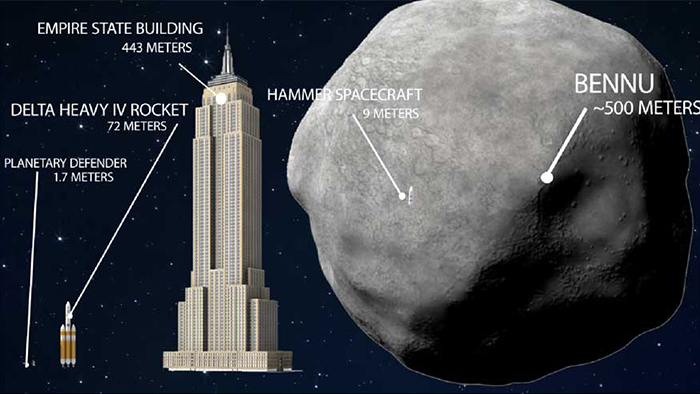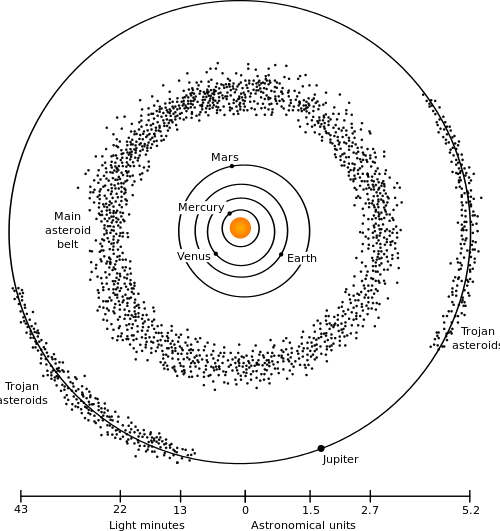This Is Our Plan For Deflecting a Massive Asteroid Heading Straight For Us in 2135
HAMMER time.
By our best estimates, the huge Bennu asteroid has around a 1-in-2,700 chance of slamming into Earth sometime in the 22nd century. Slim as those odds may be, plans are already underway to try and put the rock off course, should it get too close.
What scientists are proposing is a rocket called HAMMER, or the Hypervelocity Asteroid Mitigation Mission for Emergency Response vehicle. The idea is that HAMMER would act as a battering ram to deflect Bennu away, or blast it into smithereens with a nuclear bomb.
Considering Bennu would hit with 1,200 megatons of kinetic energy – around 80,000 Hiroshima bombs – it’s probably better to be safe than sorry. At the moment, the potential impact date calculated by researchers is 25 September 2135 – a Sunday – and scientists have just published new findings on our emergency options.
“The chance of an impact appears slim now, but the consequences would be dire,” says one of the national planetary defence team, Kirsten Howley from the Lawrence Livermore National Laboratory (LLNL).
“This study aims to help us shorten the response timeline when we do see a clear and present danger so we can have more options to deflect it. The ultimate goal is to be ready to protect life on Earth.”
Still just a concept for now, HAMMER would weigh in at close to 8,000 kilograms (17,637 lbs) and stand some 9 metres (29.5 feet) tall. Bennu, by comparison, is around 492 metres (1,614 feet) wide, and weighs around 79 billion kilograms or 174.2 billion pounds – that’s 1,664 times as heavy as the Titanic.
HAMMER would get fired at Bennu on board a Delta IV Heavy, the world’s second highest capacity launch rocket, behind the SpaceX Falcon Heavy.
What the new HAMMER study looks at in particular is when would be the best time to put our deflection system into action. Launch too early, and it’s difficult to predict what the asteroid will do; launch too late, and the gigantic rock gets harder to move.
 (LLNL)
(LLNL)
Howley and her colleagues determined that if we waited until 25 years before Bennu hit, we might need between 7 and 11 individual HAMMER rockets to do the job. Sit on our hands until 10 years before impact, and that number would rise as high as 53.
Every additional rocket launch means more opportunity for something to go wrong, however, and ultimately the researchers concluded that as a battering ram alone – technically, a kinetic impactor – HAMMER isn’t up to the job.
“When many launches are required for a successful deflection, the mission success becomes more difficult, due to the failure rate associated with each individual launch,” says one of the team, physicist Megan Bruck Syal from LLNL.
Instead, the researchers say, it would be a better idea to load a nuclear bomb on HAMMER to blast Bennu in a different direction. Despite what you might have seen in Armageddon, the idea would be to detonate the bomb some distance from the asteroid.
By flooding one side of Bennu with X-rays, part of the asteroid would then be vaporised, providing the necessary thrust as the melted material gets ejected from the rock.
As you might imagine, there are a lot of variables here, and still more than 100 years to wait. Fortunately, Bennu passes close to Earth every six years, so we can keep a close eye on what it’s doing and the route it’s taking.
There’s also a probe en route to Bennu looking to gather more information about it.
However, more than 10,000 near-Earth objects have been spotted by NASA so far, and we can’t track all of them as well as we can track Bennu. A little over 2,500 of these are estimated to be the same sort of size as Bennu is.
If something that size hit, experts predict it would fall short of wiping out humanity as we know it. An asteroid would need to be at least 1 kilometre (0.62 miles) wide to cause a mass extinction event, scientists say – the one that saw off the dinosaurs measured around 10 kilometres (6.21 miles) across.
Of course a hit of any size would be catastrophic for at least part of the planet, so vigilance is key. Experts say we could lessen the damage of an imminent asteroid strike with as little as a month’s warning – but in that scenario the Armageddon-style nuclear blast actually would be needed to blow it up into smithereens, which would then rain down on Earth.
“Delay is the greatest enemy of any asteroid deflection mission,” says Howley. “That’s why there’s urgency in getting viable deflection platforms on the shelf today.”
The research has been published in Acta Astronautica.
